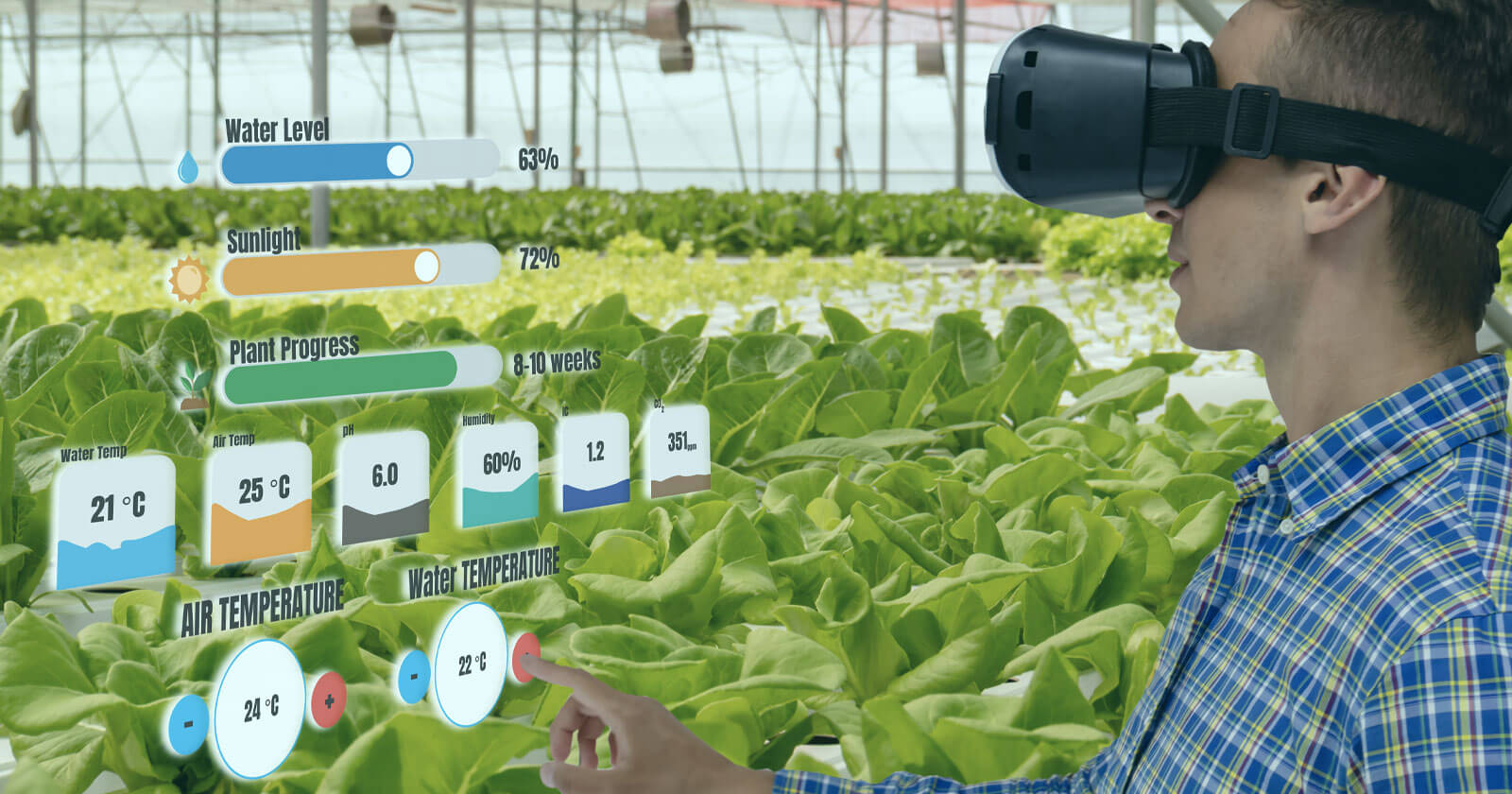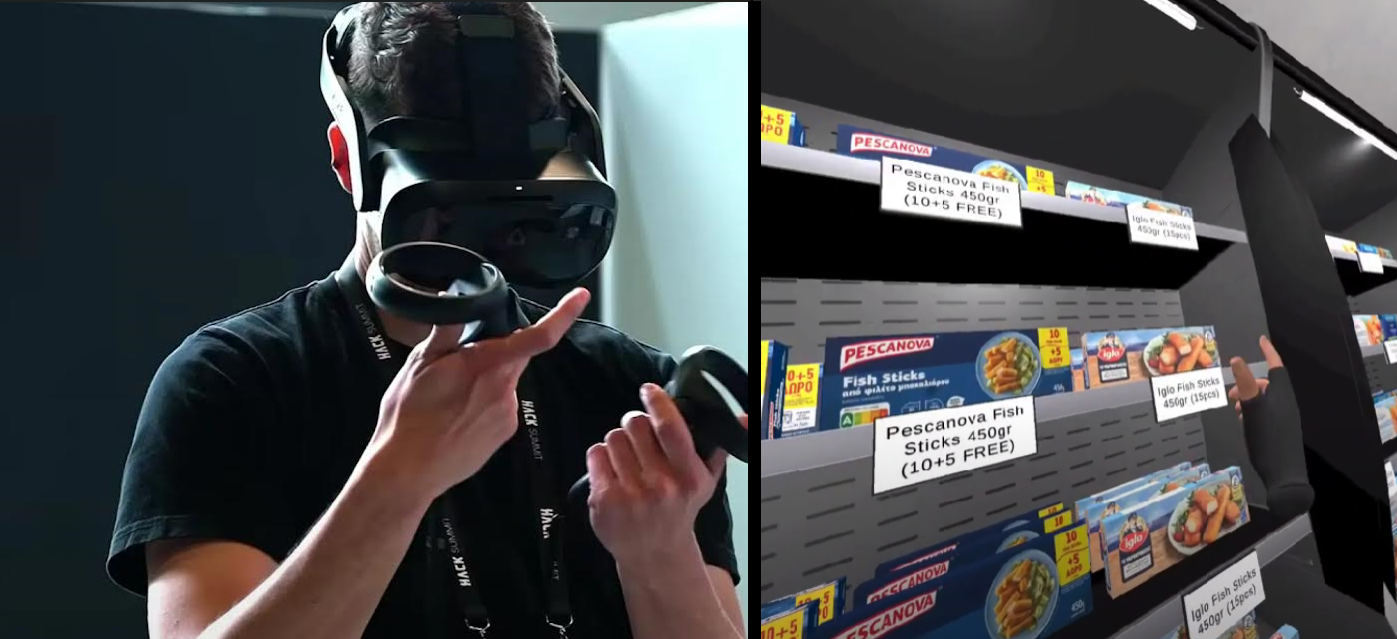Mar 5, 2024
The Potential of Virtual Reality in AgriFood and Consumer Behavior

Image source: https://www.visartech.com/blog/how-virtual-and-augmented-realities-help-agriculture/
Written by: Niko Simos and Theodoros Sofianos
March 5, 2024
VR and Agrifood: The Dynamic Duo for a Sustainable Future
Virtual reality technology (VR), often associated with gaming and entertainment, is slowly permeating into different sectors of the economy, transforming operations, and improving efficiency. One such under-anticipated industry experiencing this groundbreaking revolution is the agri-food sector.
Veering away from its predominating image as a novelty or mere tool of entertainment, Virtual Reality has proven its immense utility in fields as diverse as education and healthcare. In academia, VR becomes a powerful pedagogical tool providing immersive, hands-on learning experience for students. This enables them to travel in a virtual world, wandering through historical events or diving deep into the heart of complex scientific conceptions. Novelties turn into an effective, engaging learning medium.
In healthcare, VR acts as a transformative agent, revolutionizing medical practices. Surgeons can now practice intricate procedures in risk-free environments, thus enhancing their skill set without the potential danger to patients. The technology also introduces breakthrough therapies for managing both physical pain and mental health conditions. The global VR market size projected to increase from less than 12 billion U.S. dollars in 2022 to more than 22 billion U.S. dollars by 2025.
In what ways can virtual reality assist in farming and food production?
Agriculture and virtual reality may seem like a peculiar pairing, mostly due to the divergent natures of the industries. While one grapples with the tangible, soil-rich environment in the real world, the other thrives in an entirely fabricated digital world. However, the intersection of these two fields serves as an agricultural innovation. (VR) can be used to simulate various agricultural scenarios, helping farmers make informed decisions.
Farmers, researchers, and agronomists are adopting this technology to address important issues such as crop disease, pest control Virtual Reality can be used to simulate the impact of pests and diseases on crops, helping farmers develop effective control strategies, VR technology can be used to create virtual tours of farms, allowing consumers to see where their food comes from, distribution, VR can provide immersive training for farmers, reducing the need for physical presence in the field. By eliminating the physical limitations and leveraging the capabilities of VR, they can visually engage, in an immersive environment, stimulating conditions or scenarios that may otherwise be impossible or impractical in the real world.
Virtual Reality Applications in Agriculture
From immersive education experiences that take you right to the heart of agriculture, to pest control and specialized vr training in Vertical Farming, where in-demand skills are mastered, and captivating virtual farm tours that transport you to the fields. Not to mention, that VR is transforming new product launches in this ever-evolving industry.
Here are some ways VR can be used in agriculture education:
- VR Training Programs: VR experiences have the power to recreate the entire agricultural lifecycle – from planting the first seed to nurturing crops and reaping the harvest. By stepping into the virtual fields, trainees are afforded a unique opportunity to not only learn but to truly experience the intricacies of agriculture. VR training programs for farmers have shown to improve knowledge retention by up to 75% compared to traditional methods.
- Virtual Farm Tours and Educational Experiences: Virtual reality farm tours have emerged as a powerful tool, opening up new avenues for online learning and widening access to the world of agriculture. Among the remarkable innovations in this field, the work of Cornell researchers shines brightly, as they have meticulously crafted the most advanced virtual reality urban farm tour to date. These immersive experiences not only inform but transport participants into the heart of agriculture, offering a journey of exploration and education that knows no boundaries.
- Packaging and consumer behavior: In terms of consumer behavior, VR has a significant impact. It enhances the shopping experience by providing a more immersive and interactive way for consumers to explore and evaluate products. With VR, consumers can visualize products in a three-dimensional space, examine details, and even try them virtually before making a purchase. This immersive experience increases consumer engagement and can lead to higher levels of satisfaction and loyalty. By analyzing consumer behavior and preferences, VR can create customized packaging solutions that enhance consumer loyalty and satisfaction. This personalized approach to packaging design can have a positive impact on consumer perception and purchasing decisions.
Virtual Reality technology in Farm Tours, Education and Training
FarmVR is leading the charge in this area, offering immersive, virtual reality simulations on workshops and virtual training programs as a learning experience. Such initiatives aim to enlighten a broad demographic - from students to professionals - about the workings of the agrifood industry and the potential of immersive technology in enhancing its operations and reach.
The trailblazing digital landscape at FarmVR has been instrumental in redefining various aspects within the agri-food sector, including virtual training, and virtual farm tours.
Among the offerings of FarmVR are their enthralling virtual farm tours using vr headset. These tours seamlessly amalgamate 360° visuals and filmography with interactive components, providing audiences with an immersive agricultural experience. As viewers engage with supplementary content such as PDFs, videos, and images, they are gently escorted into hitherto inaccessible facets of the farm, owing to biosecurity or safety parameters. The tours are self-paced, providing viewers with the autonomy to explore, interact, and delve into the intricacies of the farm at their discretion.
In their endeavor to make educational platforms more engaging, FarmVR presents Virtual Reality Farming experiences at agricultural events and shows. Capable of entertaining up to 300 attendees per day, these immersive experiences breathe life into the Ag Show, creating a memorable impact on the participants.
How does virtual reality influence consumer behavior in the agrifood industry?
In the ever-evolving world of consumerism, the packaging of a food product plays a crucial role in influencing purchasing decisions. Packaging plays a crucial role in ensuring the food safety, quality, and preservation of food products. Today, more than ever, consumers are becoming increasingly conscious of the environmental impact of their choices, increasing demand for eco-friendly packaging solutions that align with sustainable practices. Consumers are actively seeking products that are not only delicious but also packaged in materials that are kinder to the planet and with respect to environmental impact and ensure food safety. This shift in consumer preference has prompted food manufacturers to reevaluate their packaging strategies and adopt innovative, eco-friendly alternatives to cater to the evolving demands of the market.
Among the pioneering players in vertical farming, the packaging that some companies such as Oishii,Aerofarms, and Yasai choose is unique. These industry leaders have gone beyond just offering delicious and nutritious produce; they have managed to capture consumer attention with their eye-catching packaging designs.
One innovative company that helps NPD (New Product Developments) in the food sector optimize their product launches is Digital Bites through its VR research platform and data analysis. Digital Bites enables researchers to easily design and implement VR neuromarketing and behavioral experiments.
Digital Bites offers companies a valuable tool to assess the suitability of their packaging for consumers and determine if any improvements are necessary. By creating a virtual supermarket that replicates real product shelves, the platform allows researchers to place various products for evaluation. Participants take part in the study using vr headset and their conscious and unconscious behaviors are analyzed using a combination of qualitative and quantitative data gathered through questions, behavioral analysis, and biometrics.

The comprehensive results are presented through graphs and tables for each subject, showcasing:
- Levels of attraction - measured through eye-tracking and behavioral analysis,
- Preferences - evaluated through behavioral observation and interviews,
- Usage patterns - derived from behavioral analysis,
- Intention to purchase - examined through behavioral assessments and interviews, and
- Overall sentiment - obtained through biometric data and interviews, for each product under scrutiny.
This data-driven approach provides valuable data analysis and insights that can guide companies in optimizing their packaging strategies for enhanced consumer appeal and engagement.
The initial focus of Digital Bites is the food industry, for two reasons. Primarily, because new product launches in the food industry have an 80-90% failure probability, resulting in huge financial losses while also making innovators more hesitant and risk averse. The second reason is that the research tools and methodologies available for food consumer and NPD researchers to test and validate new product concepts are not appropriate or suitable to their needs; they are slow to execute, provide inaccurate information and little to no consumer context to researchers.
Virtual Reality in conclusion
Virtual reality can become an agricultural innovation, making agriculture and food more consumer-focused, sustainable, and interactive. It's being used for virtual training, education, customer experiences, and to enhance new product launches through packaging design and consumer research. As VR technology advances, its impact on the industry grows.
Merging technology with agricultural expertise, virtual reality is revolutionizing the food industry. Its influence extends to sustainability, education, and consumer engagement. Virtual reality training promises a future with immersive and interactive experiences, shifting how we create, package, and consume food.
